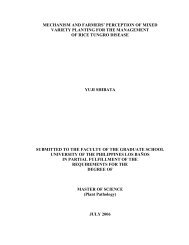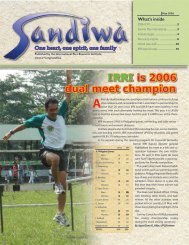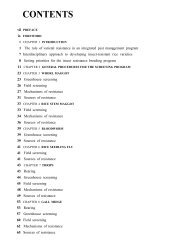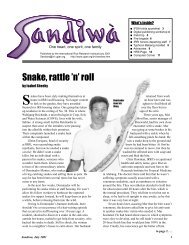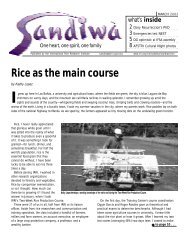Untitled - International Rice Research Institute
Untitled - International Rice Research Institute
Untitled - International Rice Research Institute
Create successful ePaper yourself
Turn your PDF publications into a flip-book with our unique Google optimized e-Paper software.
gray, becoming dark near the margins with 1-cm submerged<br />
advancing mycelia. The colony on the reverse<br />
side of the agar plate is slightly zonated and<br />
dark purplish gray, becoming lighter outward.<br />
Colonies on VJA incubated at ART (28–30 °C)<br />
grow very slowly and attain a 2.96-cm diam in 5 d.<br />
They appear azonated, felted with even margins, and<br />
white with light gray portions. The colony on the reverse<br />
side of the agar plate appears azonated and<br />
brown-purple. At 21 °C under alternating 12-h NUV<br />
light and 12-h darkness, colonies grow very slowly<br />
and attain a 2.04-cm diam in 5 d. They appear zonated,<br />
slightly floccose to felted with radial furrows,<br />
and gray, becoming light gray toward the margins.<br />
The colony on the reverse side of the agar plate is<br />
zonated with radial wrinkles and brown-purple,<br />
becoming lighter toward the margin. At 28 °C under<br />
alternating 12-h fluorescent light and 12-h darkness,<br />
colonies grow very slowly and attain a 2.96-cm<br />
diam in 5 d. They appear azonated, becoming<br />
slightly zonated toward the margin, slightly felted<br />
with radial furrows and even margins, and gray,<br />
becoming lighter outward. The colony on the reverse<br />
side of the agar plate is azonated, becoming<br />
zonated toward the margins, with radial wrinkles<br />
and brown-purple, becoming lighter outward.<br />
Seedborne fungi causing stem, leaf sheath, and root diseases in rice<br />
Fusarium moniliforme Sheld.<br />
syn. Fusarium heterosporum Nees<br />
Fusarium verticillioides (Sacc.) Nirenberg<br />
Lisea fujikuroi Sawada<br />
teleomorph: Gibberella fujikuroi (Sawada) S. Ito<br />
Gibberella moniliformis Wineland<br />
Gibberella moniliforme<br />
Disease caused: bakanae, foot rot<br />
a. Symptoms<br />
The most conspicuous and common symptoms<br />
are the bakanae tillers or seedlings—an abnormal<br />
elongation of seedlings that are thin and yellowish<br />
green. These can be observed in the seedbed and<br />
in the field. In mature crops, infected plants may<br />
have a few tall, lanky tillers with pale green flag<br />
leaves; leaves dry up one after the other from<br />
below and eventually die. If the crop survives,<br />
panicles are empty.<br />
b. Occurrence/distribution<br />
The disease is widely distributed in all rice-growing<br />
countries (Fig. 28). The pathogen detected in<br />
Africa is closely associated with that from maize<br />
and sorghum.<br />
c. Disease history<br />
This disease has been known since 1828 in Japan.<br />
In India, the disease was described as causing<br />
foot rot in 1931. Fujikuroi found the teleomorph<br />
and the fungus was placed in the genus<br />
Gibberella as G. fujikuroi with Fusarium<br />
moniliforme as its anamorph.<br />
d. Importance in crop production<br />
The disease can be observed in seedbeds and in<br />
the field. Infected seedlings are either taller than<br />
normal seedlings or stunted. Infected mature<br />
plants eventually wither and die. When such<br />
plants reach the reproductive stage, they bear<br />
empty panicles. Across different rice production<br />
situations, bakanae can cause 0.01% yield loss in<br />
Asia.<br />
Detection on seed<br />
a. Incubation on blotter<br />
Using the blotter test, F. moniliforme can be observed<br />
on rice seeds 5 d after incubating seeds<br />
under NUV light at 21 °C. The detection frequency<br />
is about 28.1% on seeds coming from<br />
different regions (Fig. 29a,b).<br />
b. Habit character<br />
There are abundant aerial mycelia, floccose to<br />
felted, with loose and abundant branching, dirty<br />
white to peach. The conidiophores terminate in<br />
false heads and dirty white to peach pionnotes<br />
may be present (Fig. 30a-c).<br />
31



